The Cantabrian mountains, a place to visit

The Sierra del Cantábrico is a region located south of Álava. To the west it coincides with the Sierra de Toloño (we in the explanation consider that both are coincident) and to the east it borders the Sierra de Codés. To the south extends the Ebro valley. From Toloño or Herrera, the vineyards and fields of La Rioja are a spectacle.
From an ecological point of view, the Sierra del Cantábrico is an environment of great interest. Its peaks (the highest are around 1400 m) limit between humid and dry climates. Runoff to the north is exposed to humid winds and suffers a humid Atlantic climate. However, south-facing watersheds are influenced by dry winds and dominate a more dry Mediterranean climate. This situation is reflected in the landscape and ecology, where you can observe how the humid forests of umbria become dry calendar forests.
Geological observations
The mountains of Toloño, Cantabria and Codés form a medium height massif. The average height of the mountains is 1000 meters and there are many that exceed 1300 meters (Peña del Castillo, 1430 m; Peña León, 1391 m); Peña de San Tirso, 1338 m; and Codes 1421 m). In the northern valleys are the basins of the Inglares and Ega rivers.
Most of the complementary materials of the Sierra Cantabrian come from the Cretaceous. The most abundant materials are limestone, dolomite, calcarenite, sand, sandstone and clay.
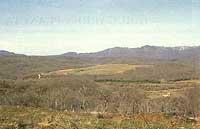
In the northern valleys river sedimentation is mainly formed by clays, sands and silts. In the south of the mountain (apparently inclined and torn) predominates the rocky, although clays, sands and sandstones also appear.
Changing forest
The forests that cover this territory are much and changing. Since there is a transition between both climates, the conditions are different. There is an influence of the predominant oceanic climate in practically all of Euskal Herria. On the other, on the contrary, it is influenced by a drier and Mediterranean climate, that of La Rioja and the Ribera de Navarra. The location of the saw is the cause of this phenomenon.
The Sierra del Cantábrico extends from east to west and constitutes an important natural barrier in the course of the winds. It produces significant climatic differences between its northern and southern slopes. Winds from the Atlantic lead northwest. The wind loaded with moisture increases when cracking and cooling leaves the humidity in the form of fog or rain. In the sun lowers dry air. Therefore, in the laiotz the beech grows and in the sun the art.
Therefore, in this region there is a vegetation of two types: the one that grows in humid conditions and the one that grows in dry conditions.
Hayedo
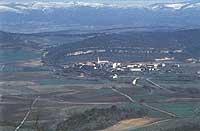
On the slopes facing north are large beech trees in the Sierra del Cantábrico. The substrate of these forests is limestone. Next to the beech appears abundant common boxwood. The appearance of the boxwood indicates that the climate is drier and continental than in the beech trees further north. In moist beech accompany holly and cranberry.
In these beech trees are abundant birds of prey, such as the royal kite and the hawk, which are easily observed. The areas with low slopes are the most suitable, especially those of Peñacerrada-Urizaharra, Pipaona and Lagrán.
Ameztia
Ametza is very abundant in the Cantabrian mountains. The bitterness of schiz is the largest in Alava and has a great ecological interest. This forest grows on sandy soils. These soils are not suitable for agriculture, so the Izkiz forest has remained in very favorable conditions. Along with the Izkiz bumblebee, bushes like holly, juniper, chillar and slang abound.
Izkiz forest generates favorable ecological conditions for the massive collection of vertebrates. The wild boar, badger, hare and fox find an appropriate place to eat and hide. On the other hand, there are numerous birds of prey (black and red kite, gabiraia, lesser eagle, black tree and red hawk), but the most interesting thing is that the reproduction of the azor, very scarce, has been shown in this region.
Quejigal
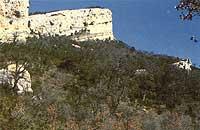
The whining was the main tree species that colonized the bottom of the valleys. However, because these soils are very productive for agriculture, quejigales have been greatly reduced for agricultural plantations. Quejigal does not normally grow alone and is accompanied by art, beech or grandmother. However, to the north of Peñacerrada-Urizaharra there are some quejigales of interest. In it the birds of prey find a favorable environment, so they are the lesser eagle, the eagle and the eagle ash the most seen.
In a oak grove mixed with beeches between Pipaona and Lagrán a spotted hawk has been detected.
In the mammals, which can be found in the quejigal, stand out the wild cats, the garduñas and the wild boars.
Incinar
Although in their day the arts covered much of the Albanian territories, the human pressure they have suffered for some time has considerably reduced the extent of the Albanian holm oaks. It is difficult to find adult holm oaks around the Cantabrian mountain range. Carrascales formed by small grains (chaparrones) are more numerous.

The oak abutment consists mainly of boxwood, woodpeckers, junipers and common cockles. In the high areas with humidity, heather is added to the previous ones and more Mediterranean species in the drier low areas, such as thyme, horse grapes and fine salmon.
The group of mammals is very abundant and abundant in the holm oak. They highlight the wild cat, the gineta, the fox, the spiny, the garduña, the turón and the wild boar. On the other hand, some birds of prey such as the royal eagle or the culebrera eagle are of their nesting pleasure.
Riverside vegetation
It is known that the forests that grow on the river bank, called sotos, constitute a very rich and very important ecosystem. The riverside forests that surround the Sierra Cantábrica cover an area lower than the one that formerly belonged to it. Obtaining agricultural land has been the main cause of this fact. These forests play a very special role as flood regulators, but are currently under heavy pressure. Wood and riverbed cleaning are the actions that most affect riverside forests.
The vegetation of the riverside forest consists of alder, willows, ash, elm, hazelnut, coffers, zumalakarras, bridges, hard and cliffs. This environment is very suitable for many birds and with water you can find a representative selection of sawn birds, such as the wild duck, uroilanda, coquetazuria, chestnut and kingfisher.

On the other hand, in the water streams that are preserved in their authenticity, you can also see a very scarce otter in Euskal Herria (of course, with good luck! ).
Rock communities
The gravel and rocks of the Sierra Cantábrica create an environment conducive to the life of several birds. In the rocks of Peña Gaztelu is a rich community of birds of prey. In it you can see unconventional species such as the royal eagle and the peregrine falcon. On the other hand, lizards and rocky pigeons nest in the place, something that does not happen elsewhere in the Basque Country.
In addition, in the area of Arluzea nests the few griffon vultures of this region.
What to see and where to go
In the publication of the aforementioned Basque Government, some of the itineraries that the visitor can make in the vicinity of the Cantabrian Line are collected. We recommend two of them.
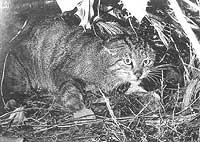
The first route starts from the port of Rivas. On the port is born a track that runs through the northern drain of the sierra. The track begins to ascend slowly along the northern slope of the mountain. The views are beautiful and allow you to enjoy the beauty of Peñacerrada-Urizaharra and its surroundings. After a quiet hour and a half walk and a slight descent on the last climb, we reach the pastures located north of Mount Toloño. Here we will find covers and closures for the management of livestock and livestock. To our left, behind a beech that ascends in slope, are the rocky rocks of Toloño. The ascension is now more painful, but the Riojana view that is offered to us upwards compensates the effort. At our feet and with the mountains of Ezkarai on the horizon, the Ebro River develops between its vineyards large circular meanders.
The second route allows us to know the foz of Izkiz. The road begins in the beloved village of Corres. Following the path that runs along the river that runs through the village, we will enter the foz of Izkiz. In the immediate vicinity of the river Izkiz is a forest of closed banks. The foz extends through the center, where a small reservoir is located. Next to the dam of the reservoir there is a small waterfall and from there you can choose two paths. What we have brought so far rises a little, taking height. The news advances between the trees located next to the bed that is born in the marsh and our image is more beautiful than the other. Once the channel and the initially adopted roads reach the same height, we can say that the canyon is over and then we have two options: go ahead and reach the village of Bujanda or back.
This article mentions the names of many birds of prey, which can cause confusion among readers. For most of them it is difficult to distinguish between the hawk, the kite, the azor or the eagle. We want to help this identification and therefore, in addition to giving the sweet male to some of these birds, we will make a brief description.

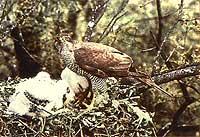
Black Milano: 55 cm. Dark reddish brown feather. Tail slightly hung.
Azor: 48-61 cm. Dark pen on the back and dark brown listed on the chest.

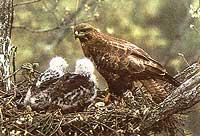
Red Milano: 60 cm. Reddish pen. Very sparked tail.
Common falcon: 51-51 cm. Variable color pen, grey to dark brown. Clear line on the chest. Short tail.
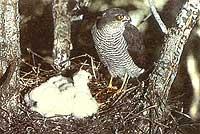
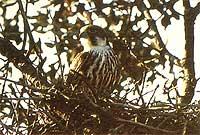
Gavilán: 28-38 cm. Males feather gray on the back and reddish listed on the chest. Females of brown feather in the chest.
Tree falcon: 30-36 cm. Reddish thighs. Chest listed. Dark brown back.
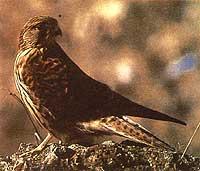
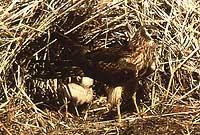
Kestrel: 34 cm. Black tail. Reddish back males and females listing.
Ash Eagles: 41-47 cm. Males head and back gray. Grey wings, black-black tips and two black lines. Females dark brown back and on wings more than two black lines.


Golden eagle: 62-67 cm. In flight the bottom is almost white. Brown back.
Royal Eagle: 80-86 cm. Uniform dark brown pen. Head and golden nape.
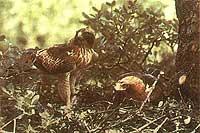
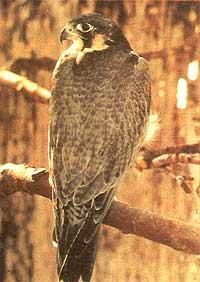
Small eagle: 43-45 cm. Dark or light brown pen. The legs are covered with feathers.
Peregrine falcon: 38-50 cm. Female much larger than male. Blue grey back. Reddish chest with black lines. Large moustaches on the cheeks.





